- News
- Reviews
- Bikes
- Accessories
- Accessories - misc
- Computer mounts
- Bags
- Bar ends
- Bike bags & cases
- Bottle cages
- Bottles
- Cameras
- Car racks
- Child seats
- Computers
- Glasses
- GPS units
- Helmets
- Lights - front
- Lights - rear
- Lights - sets
- Locks
- Mirrors
- Mudguards
- Racks
- Pumps & CO2 inflators
- Puncture kits
- Reflectives
- Smart watches
- Stands and racks
- Trailers
- Clothing
- Components
- Bar tape & grips
- Bottom brackets
- Brake & gear cables
- Brake & STI levers
- Brake pads & spares
- Brakes
- Cassettes & freewheels
- Chains
- Chainsets & chainrings
- Derailleurs - front
- Derailleurs - rear
- Forks
- Gear levers & shifters
- Groupsets
- Handlebars & extensions
- Headsets
- Hubs
- Inner tubes
- Pedals
- Quick releases & skewers
- Saddles
- Seatposts
- Stems
- Wheels
- Tyres
- Health, fitness and nutrition
- Tools and workshop
- Miscellaneous
- Buyers Guides
- Features
- Forum
- Recommends
- Podcast
review
£8,500.00
VERDICT:
Flawless performance from Specialized's all-new Tarmac
Weight:
6,350g
Contact:
At road.cc every product is thoroughly tested for as long as it takes to get a proper insight into how well it works. Our reviewers are experienced cyclists that we trust to be objective. While we strive to ensure that opinions expressed are backed up by facts, reviews are by their nature an informed opinion, not a definitive verdict. We don't intentionally try to break anything (except locks) but we do try to look for weak points in any design. The overall score is not just an average of the other scores: it reflects both a product's function and value – with value determined by how a product compares with items of similar spec, quality, and price.
What the road.cc scores meanGood scores are more common than bad, because fortunately good products are more common than bad.
- Exceptional
- Excellent
- Very Good
- Good
- Quite good
- Average
- Not so good
- Poor
- Bad
- Appalling
What. A. Bike. The redesigned S-Works Tarmac – lighter, more aero and comfortable – provides superlative performance. It's a big step forward from the previous bike, and the changes push it firmly into superbike territory. It does everything extremely well; its performance is flawless.
The Specialized Tarmac should need no lengthy introduction. It's been around since 2003 and has evolved over the years to meet the needs of the most demanding bicycle racers sponsored by the US company, and in the process has won numerous victories in the biggest races – most recently at the time of writing, the 2017 World Championships in the hands of Peter Sagan.
> Find your nearest dealer here
The 2018 version is the sixth generation and the changes are substantial; less a refinement and more a clean sheet redesign, with a focus on reducing weight, improving comfort, frame stiffness and, for the first time since the original Tarmac, added aerodynamics. It's initially available with rim brakes with the disc brake Tarmac coming next year, and is priced from £3,500 to £9,000. The model on test is the £8,500 S-Works Tarmac SL6.
Ride and handling
The performance of this new S-Works Tarmac is absolutely stunning. I've been riding it for the last few weeks, doing everything from big rides in the hills to flat-out fast chain gangs and even the occasional 60km office commute, and it hasn't done anything but impress every time I've been on it. So complete and rounded is its performance that I don't hesitate in saying this is one of the best race bikes currently available.
Specialized's goal in the redesign was to make the Tarmac better, and that is definitely something that has been achieved. I've tested numerous iterations of the previous SL5 and always found it to be a competent, if not stellar, performer. The changes to the Tarmac move it firmly into superbike territory; it's now up there with the very best money-no-object bikes I've reviewed for road.cc over the years.
The new Tarmac is much lighter than the previous bike, and this lovely S-Works build with Shimano Dura-Ace Di2 and Roval CLX 50 carbon wheels makes the most of the weight savings to produce a 6.35kg (13.99lb) build. Lighter would certainly be possible: an Ultralight frame sheds more weight with a 10g paint finish and shallower wheels, for £9,000.
Still, this bike is no heavyweight and it's certainly no slouch, with a scintillating performance on rolling terrain and in the hills which typifies my local testing roads. There's no lag or delay in the way it responds to your power, it zips up to speed very quickly, and on undulating roads it maintains momentum in the way you expect of an out-and-out aero bike. Yet when it's time to scale a 20 per cent climb it feels like a dedicated lightweight climbing bike. And somehow, despite that low weight, it never felt anything but planted and stable on the roads, no feeling of skittishness ever spoilt the sublime ride.
It's sharp and agile in the way it responds to your inputs through the handlebar too, with well-weighted steering that is neither too fast nor too slow and delivers big confidence for attacking corners and descents. The bike changes direction with startling accuracy. Despite the weight savings there's no shortage of stiffness, with a very reassuring feeling of stoutness from the front of the bike that ensures there's no vagueness when you're really pushing on at pace. And when you're doing your best Peter Sagan sprinting impression, the bottom bracket stiffness is more than adequate, despite the new slimmer BB design.
I always felt comfort was something the previous Tarmac was never short of, but the new bike provides a noticeable improvement in this department. The new seatpost with its top section engineered to provide flex – it visibly flexes when you press down on it too – really delivers fantastic seated comfort.
The way the front end handles coarse road surfaces is also impressive. With the 26mm wide Turbo Cotton tyres inflated to about 90psi the Tarmac is hugely compliant. There were never any nasty bangs or shocks through the handlebar even when the front wheel hit a series of potholes. Granted, it's no endurance bike – it doesn't compare to the Roubaix for example – but it's more composed than other overly stiff carbon race bikes I've ridden. There's even space for up to 30mm tyres if you want even more comfort for daily riding.
To sum up, the new Tarmac is a real joy to ride, as you'd obviously hope of such an expensive bike, but I've ridden bikes in this price range that haven't impressed in the same way.
Frame design
The headline-grabbing news with the new Tarmac is the low weight. A massive 200g has been shed from the previous version, with a claimed 733g weight for a 56cm frame. That's an impressive saving and puts the new Tarmac within a hair's breadth of the lightest race frames available from rival brands such as Trek, BMC and Canyon.
But there's more to the new Tarmac than just that impressive weight saving. The real feat of engineering has been in the aerodynamic wizardry that Specialized has injected into the new bike, thanks in huge part to Specialized having its own wind tunnel to verify its findings in computer simulations. Aerodynamics used to mean a weight penalty, but the new Tarmac is claimed to be as aero as the original Venge, a dedicated aero bike, yet it's far lighter than any dedicated aero bike.
We have no way of independently verifying Specialized's claims of course, but you can certainly see the aero influences. The fork blades are slim and the seatstays are dropped further down the seat tube, just like on the Venge. There's a D-shaped profile for the seat tube and new seatpost, and the rear brake is tucked lower down out of the airflow.
And you can notice the changes out on the road. Testing the new Tarmac on familiar roads with a power meter to provide some comparison data reveals that, without a doubt, it's a fast bike. As fast as some dedicated aero bikes in my opinion. Other bike brands might be producing frames that are lighter but few are also combining aerodynamics to this level. If you can have aero without the weight penalty then I can't see any reason why you wouldn't take it. Aero for free has to be a good thing, right?
Specialized introduced its Rider-First size-specific approach to frame design with the last Tarmac and has evolved it further with the new SL6. Where the previous bike used different sized tapered head tubes across the model sizes, the new Tarmac uses the same tapered head tube across the range, but three different forks with different profile blades and steerer tube taper to tune the stiffness for the smallest and largest frames.
I can't think of any other company that has developed three different forks for one bike model, and it shows a serious commitment by Specialized, not only financially because doing this can't be cheap, but also in pursuing optimum performance for each frame size.
There are some details that you might not expect on a mass-production bike, and my favourite is the carbon plate that serves to stiffen the rear brake without adding more than a few grams and helps to ensure the brake performance is crisp and dependable.
All cables are routed internally, inside the top tube on this Di2 bike, but there's a new down tube port that is compatible with other groupsets. The rear brake route is still through the top tube but the exit port has been repositioned to ensure a clean path to the brake calliper.
There's a new replaceable derailleur hanger with a lower profile and lighter design. The seat clamp is internal and easily accessed from the top tube with a rubber flap keeping crud out. I had no problems easily adjusting saddle height, and there was no slippage either. Tyre clearance is also massively improved, with 26mm tyres fitted as standard but with space for up to 30mm if you want to up the comfort.
Those changes are all wrapped up in a frame that is a big visual departure from the previous one. Out go the curves and in come straight tubes, a transition that is borne out of Specialized scaling back the diameter of the various tubes for the simple reason that a narrow straight tube is lightest. Specialized reckons that days of 'oversized stiff' are over because larger diameter tubes mean more surface area for a given wall thickness, which means more weight. It's a thoroughly modern looking bike, and there are a good selection of colours available if the stealth black doesn't float your boat.
Equipment highlights
The new Tarmac SL6 range starts at £3,500 with a Shimano Ultegra R8000 groupset. Compare that to an S-Works frameset that costs £3,250, and unless you really have your sights set on a special build, given the advances made to the latest Ultegra, that might actually be the pick of the range if you want to get onto the new SL6 platform.
It should be noted there's a small difference in the carbon fibre used. The Ultegra model uses FACT 10r carbon as opposed to FACT 12r of the highest spec models, so there'll be a small weight difference. Go the other way and the Tarmac Ultralight, with a 10g paint finish and CLX 32 wheels, costs £9,000, and is the lightest production version of the new SL6.
The S-Works Tarmac tested here is one peg down from that range-topper, with a dream equipment list for its £8,500 RRP. It all worked harmoniously and there are no changes I'd make: it's the perfect bike out of the box.
The latest Dura-Ace Di2 9150 groupset is a thing of utter joy, with fast and crisp gear changes and the direct-mount brakes solid and dependable in all situations. The junction box, through which you charge the Di2 battery and set up the gears, is now hidden at the end of the handlebar; it's a much more elegant solution than being strapped to the bottom of the stem.
Specialized's own S-Works carbon crankset with Praxis rings is the only deviation from the Dura-Ace theme but it provides good power transfer and slick shifting. It's certainly a looker, but a Dura-Ace crankset might be preferable for some. Gearing wise it's 52/36t paired to an 11-30t cassette, which provides all the gear choice you need whether you're racing or climbing mountains.
Specialized supplies the rest of the components. The Roval CLX 50 carbon clincher wheels are impressive and right up there with the best from Zipp and Enve, with great dry weather braking and adequate wet weather performance. Aero performance is good too and there's little buffeting in strong crosswinds.
Specialized has been pushing its own tyre range for a few years now and these 26mm wide Turbo Cottons are the best yet. They're grippy in all weathers, adequately dealing with the often adverse road conditions in the Cotswolds (lots of mud on the roads), and are both super-fast and, thanks to the 320TPI cotton casing, highly supple, contributing greatly to the smooth and composed ride. They also look fantastic with the tan sidewall, which does clean up pretty well after a mucky ride.
As for the finishing kit, all of it is branded with the Specialized logo, and that's no bad thing. The S-Works Toupe saddle is impressively comfortable and I'd happily (and did) sit on it all day. The SL Carbon handlebar has a pleasingly comfortable shallow drop and short reach. The aluminium stem is no-fuss, but at 100mm too short for my desired fit. The bar tape is worth a mention too: the S-Wrap with Sticky Gel provides a nice level of bump absorption as well as being very grippy with or without gloves.
Conclusion
You'd certainly hope that a bike costing £8,500 delivers an awesome performance, and, fortunately, the S-Works Tarmac doesn't disappoint. While it's an impressive feat of design and engineering, it's the way that it rides that is the best result of the complete redesign. Although it has all the credentials to be a superb race bike, it's right at home away from the demands of competition, with real-world everyday usability and comfort.
> Your complete guide to Specialized's 2018 road bike range
It's this overall balance that really impresses. Specialized has managed to wrap up the weight drop, aero savings, comfort improvements and handling refinements into a package that gels really well. Until now road bikes have been specialists: the choice between a lightweight climbing bike or an aero road bike. The new Tarmac shakes up that convention, and offers the best of both worlds with no compromise.
The Tarmac has long been a popular race and performance road bike, and the latest SL6 is the best revision in its long history. It has arguably set the benchmark for future race bikes to be measured against.
Verdict
Flawless performance from Specialized's all-new Tarmac
road.cc test report
Make and model: Specialized S-Works Tarmac SL6
Size tested: 56cm
About the bike
State the frame and fork material and method of construction. List the components used to build up the bike.
Specialized says:
"The previous Tarmac had an exceptional palmarès – a win in every Grand Tour, plus two World Championships – so you might ask yourself, "why a new Tarmac?" Well, we've never been one to rest on our laurels, which is why we're constantly hunting for even the smallest of improvements. In other words, we innovate or die. And for this exact reason, the new S-Works Tarmac breaks all the traditions of race bike design to create the fastest bike for all conditions.
To get the weight below 800 grams, we utilized advanced aerospace composite optimization software to revolutionize the construction and layup of our new FACT 12r carbon. It's the most advanced material and schedule we've ever made – the shape, schedule, and material optimization allowed us to shed nearly 200 grams. That's right, a 20% reduction in frame weight – the perfect recipe for your next hill climb PR.
In our search to save every last gram, the S-Works Tarmac Ultralight also uses a newly developed paint finish that further reduces weight. In combination with our improved preparation process, it achieves a paint job that has the same weight as nine gummy bears, or 10 grams.
We then further improved our Rider-First Engineered™ technology to ensure that the new Tarmac is stiff and compliant in exactly the right places. With this revamp, we also updated the geometry''basing it on countless Retül data points and professional rider input. This enabled us to develop a performance road geometry that perfects the combination of a responsive front end and short wheelbase, delivering instantaneous response and optimal power transfer.
And while stiffness aids in the aforementioned, compliance must also be utilized for an optimal ride quality. That's why we designed a seatpost that builds compliance into the upper 120mm where clamping doesn't happen, dropped the seatstays, and altered the seat tube shape. We also added tire clearance up to 30mm, which translates to a 28mm Turbo Cotton on a Roval CLX 50 wheel. This allows lower pressures for decreased rolling resistance, increased traction, and more comfort. Altogether, these additions still have the Tarmac riding like a true race-machine, but just takes a bit of the sting out of those road imperfections. You'll thanks us on your next long ride.
And while this is all great, we know that aerodynamics are the most important thing we can do to make you faster. Both our Bora-Hansgrohe and Team Quick Step Floors Pro Tour riders, after all, are demanding aero improvements on every bike. With this, the aero goal was to discover where we could essentially "add aero for free," by not taking anything away from the hallmarks of the Tarmac design. During the six-month iterative process, three areas were discovered where we could do this – a new fork shape, dropped seatstays with aero tubes, and a d-shaped seatpost and seat tube. The result? A bike that's approximately 45 seconds faster over 40km compared to other lightweight bikes in the same category. A speed savings that you'll feel when you're attacking off the front of the peloton.
This S-Works Tarmac comes ready to race with Shimano's new Dura-Ace 9150 Di2 groupset with direct mount brakes, and the lightweight, yet impressively aerodynamic, Roval CLX 50s with 26mm Turbo Cotton tires."
Tell us what the bike is for, and who it's aimed at. What do the manufacturers say about it? How does that compare to your own feelings about the bike?
Specialized lists these components:
Frame
S-Works Tarmac SL6, FACT 12r carbon, Rider-First Engineered™, OSBB, full internal, electronic-specific routing, internally integrated seat clamp, 130mm rear spacing
Fork
S-Works FACT carbon
Front Derailleur
Shimano Dura-Ace Di2 9150, braze-on
Rear Derailleur
Shimano Dura-Ace Di2 9150, 11-speed
Number of Gears
22
Shifters
Shimano Dura-Ace Di2 9150
Chain set
S-Works carbon fibre 52/36T
Bottom Bracket
OSBB, CeramicSpeed bearings
Cassette
Shimano Dura-Ace 9100, 11-speed, 11-30t
Chain
Shimano Dura-Ace,11-speed
Pedals
Supplied
Brakeset
Shimano Dura-Ace 9110 direct mount
Handlebars
S-Works SL Carbon Shallow Drop, 125x75mm
Stem
S-Works SL, alloy, titanium bolts, 6-degree rise
Bar Tape
S-Wrap w/ Sticky gel
Front Wheel
Roval CLX 50, Win Tunnel Engineered, carbon rim, 50mm depth, Roval AF1 Hub, CeramicSpeed bearings,16h
Rear Wheel
Roval CLX 50, Win Tunnel Engineered, carbon rim, 50mm depth, Roval AF1 Hub, CeramicSpeed bearings, 21h
Tyres
Turbo Cotton, 700x26mm, 320 TPI
Saddle
S-Works Toupé, Body Geometry shape, 143mm width, carbon rails
Seatpost
S-Works FACT Carbon Tarmac seatpost, 20mm offset
Frame and fork
Overall rating for frame and fork
9/10
Tell us about the build quality and finish of the frame and fork?
Excellent quality, as befits a £8,500 road bike.
Tell us about the materials used in the frame and fork?
Full FACT 12r carbon frame and fork with Rider-First Engineered and OSBB bottom bracket, clean routing, internally integrated seat clamp and 130mm rear spacing.
Tell us about the geometry of the frame and fork?
Anyone who has ridden the previous Tarmac will feel right at home on the new bike.
How was the bike in terms of height and reach? How did it compare to other bikes of the same stated size?
With a change to a longer stem the fit was perfect for me.
Riding the bike
Was the bike comfortable to ride? Tell us how you felt about the ride quality.
Supremely comfortable with lots of flex in the new seatpost.
Did the bike feel stiff in the right places? Did any part of the bike feel too stiff or too flexible?
Plenty of stiffness from the head tube and the bottom bracket.
How did the bike transfer power? Did it feel efficient?
Anyone this side of Peter Sagan won't find themselves shortchanged at all.
Was there any toe-clip overlap with the front wheel? If so, was it a problem?
None.
How would you describe the steering? Was it lively, neutral or unresponsive? Neutral.
Tell us some more about the handling. How did the bike feel overall? Did it do particular things well or badly?
The handling of the Tarmac makes it an easy bike to ride at any speed; it's cheesy but it really does inspire confidence.
Which components had the most effect (good or bad) on the bike's comfort? would you recommend any changes?
There's nothing I'd change, the components all worked flawlessly.
Which components had the most effect (good or bad) on the bike's stiffness? would you recommend any changes?
The wheels are fast, the tyres are supple, the saddle is comfortable and the handlebar is a great shape.
Which components had the most effect (good or bad) on the bike's efficiency? would you recommend any changes?
The wheel and tyre package really contributed to the high-level performance of the new Tarmac.
Rate the bike for efficiency of power transfer:
9/10
Rate the bike for acceleration:
9/10
Rate the bike for sprinting:
9/10
Rate the bike for high speed stability:
9/10
Rate the bike for cruising speed stability:
10/10
Rate the bike for low speed stability:
10/10
Rate the bike for flat cornering:
10/10
Rate the bike for cornering on descents:
10/10
Rate the bike for climbing:
10/10
The drivetrain
Rate the drivetrain for performance:
9/10
Rate the drivetrain for durability:
9/10
Rate the drivetrain for weight:
9/10
Rate the drivetrain for value:
9/10
Wheels and tyres
Rate the wheels for performance:
9/10
Rate the wheels for durability:
9/10
Rate the wheels for weight:
8/10
Rate the wheels for comfort:
9/10
Rate the wheels for value:
8/10
Rate the tyres for performance:
10/10
Rate the tyres for durability:
7/10
Rate the tyres for weight:
8/10
Rate the tyres for comfort:
8/10
Rate the tyres for value:
8/10
Controls
Rate the controls for performance:
9/10
Rate the controls for durability:
9/10
Rate the controls for weight:
8/10
Rate the controls for comfort:
10/10
Rate the controls for value:
8/10
Your summary
Did you enjoy riding the bike? Yes
Would you consider buying the bike? Yes
Would you recommend the bike to a friend? Yes
Rate the bike overall for performance:
10/10
Rate the bike overall for value:
9/10
Use this box to explain your score
Yes it's jolly expensive, but if money is no object and you want one of the best race and high-performance bikes currently available, the new Tarmac has to be on your shortlist.
About the tester
Age: 31
I usually ride: My best bike is:
I've been riding for: 10-20 years I ride: Every day I would class myself as: Expert
I regularly do the following types of riding: road racing, time trialling, cyclo-cross, commuting, touring, mountain biking
David worked on the road.cc tech team from 2012-2020. Previously he was editor of Bikemagic.com and before that staff writer at RCUK. He's a seasoned cyclist of all disciplines, from road to mountain biking, touring to cyclo-cross, he only wishes he had time to ride them all. He's mildly competitive, though he'll never admit it, and is a frequent road racer but is too lazy to do really well. He currently resides in the Cotswolds, and you can now find him over on his own YouTube channel David Arthur - Just Ride Bikes.
Latest Comments
- chrisonabike 28 min 30 sec ago
There you go, you had a chance to correct your tacit support for the cultural revolution (and you've been silent on the burning of the Library of...
- eburtthebike 35 min 15 sec ago
“This is unsafe and we need an outbreak of common sense...." From a tory!
- hawkinspeter 1 hour 39 min ago
To be charitable to the police (though I wonder why I should), they're acting on a specific complaint raised by the motorist and so are doing their...
- hawkinspeter 1 hour 20 min ago
Interesting to hear from someone who was involved in the Bristol-Bath path. I think it's largely a victim of its own success, most notably during...
- chrisonabike 2 hours 57 min ago
Get "rats for LTNs and modal filters" founded immediately or we're doomed!
- chrisonabike 3 hours ago
They almost never get to experience them... https://m.youtube.com/watch?v=ngifg--1eW4
- stonojnr 3 hours 8 min ago
its tricky because there are arguably hundreds, maybe even thousands of "problem areas" on any sportive route, that potentially could result in the...
- check12 14 hours 8 min ago
Surely please get down on your knees, rappers rap about gats not cats and foil isn't made from oil and can hold your all told
- David9694 15 hours 42 min ago
Elderly man sentenced following serious crash in Ringwood...
































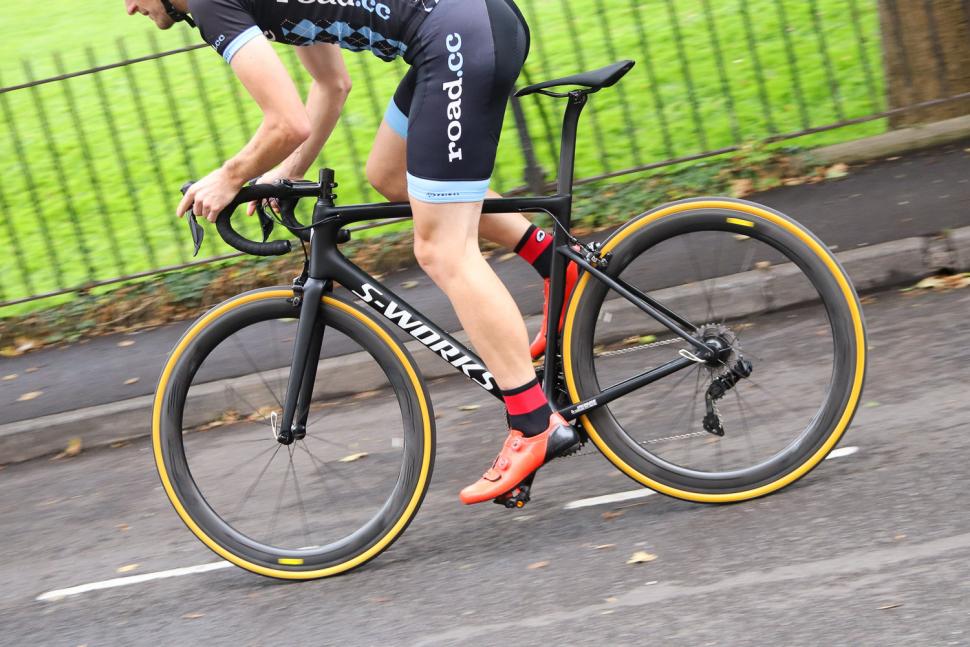
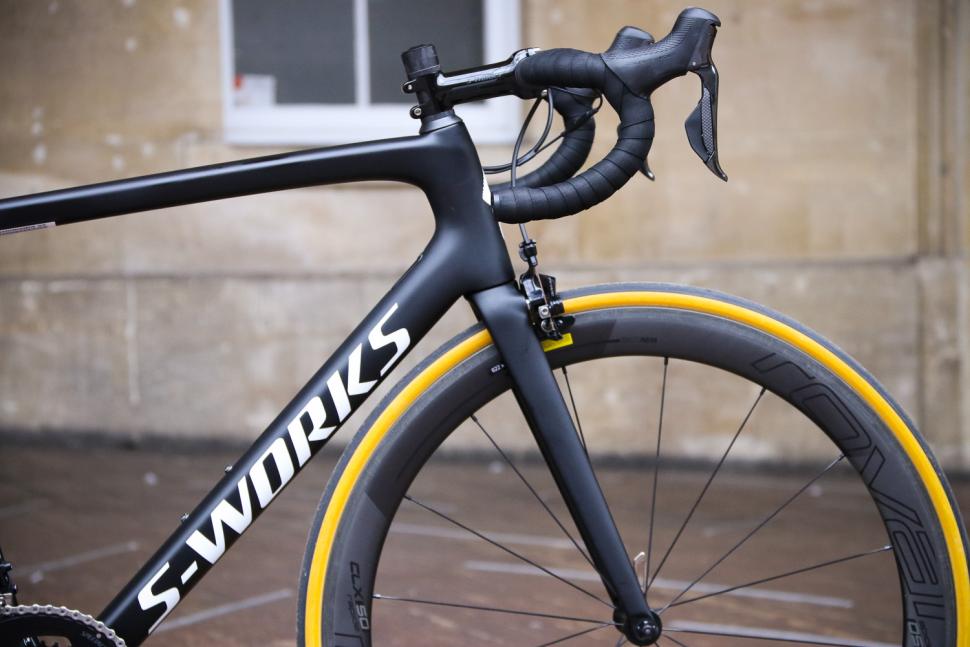
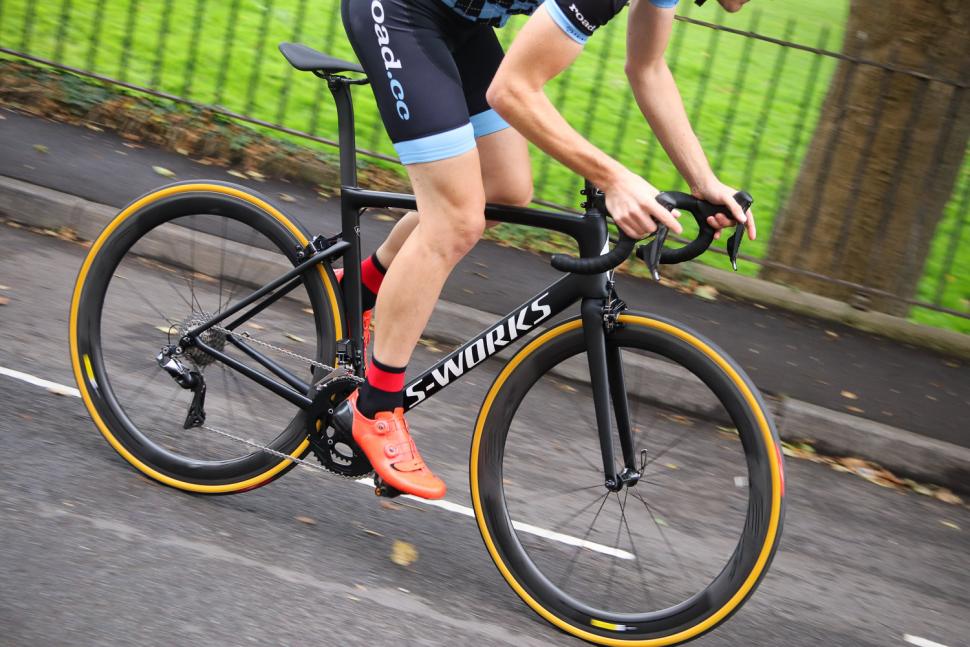
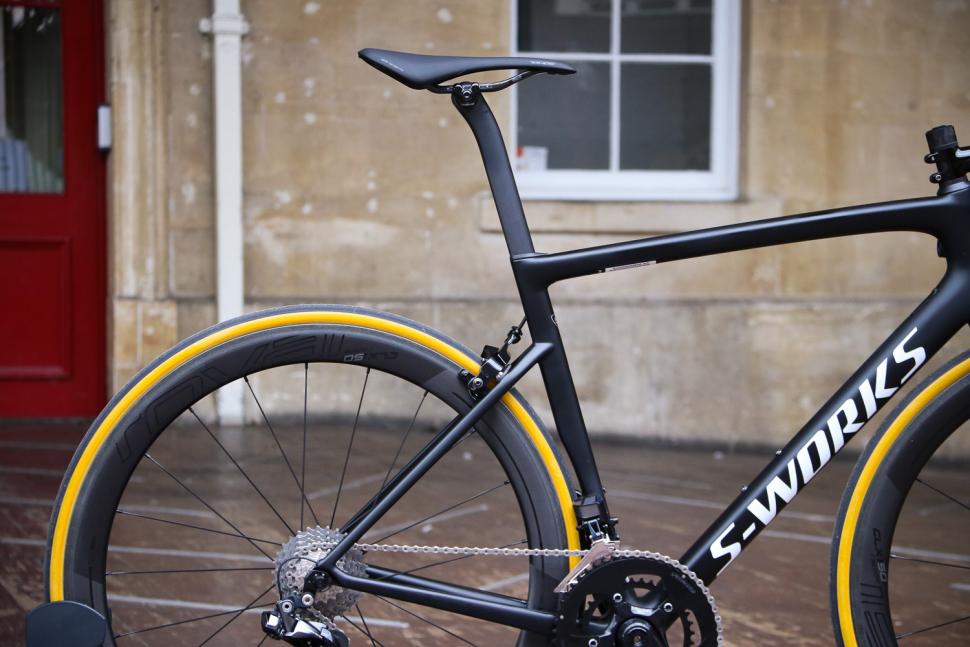

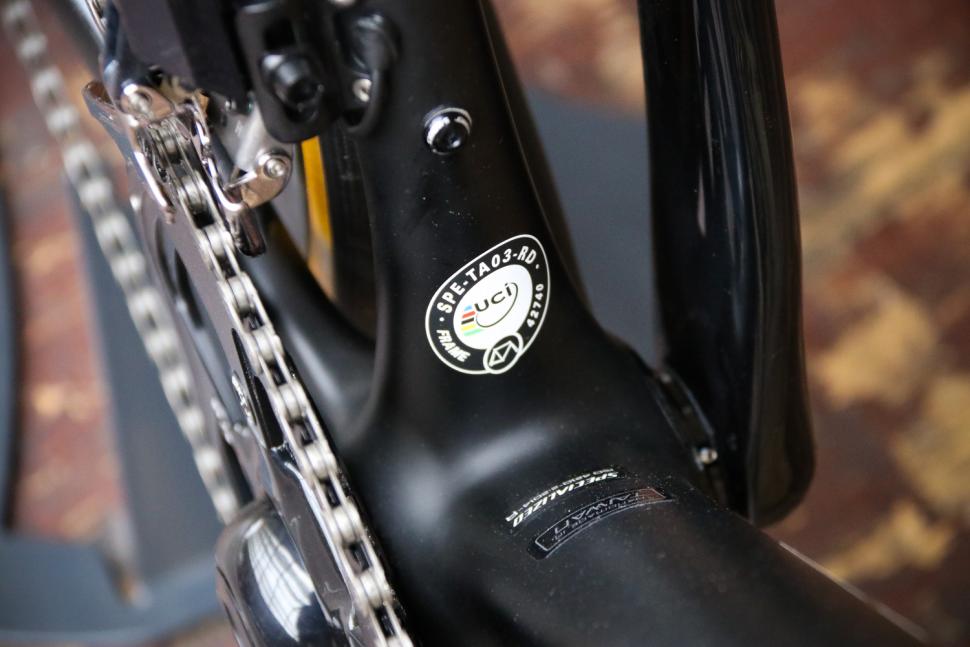
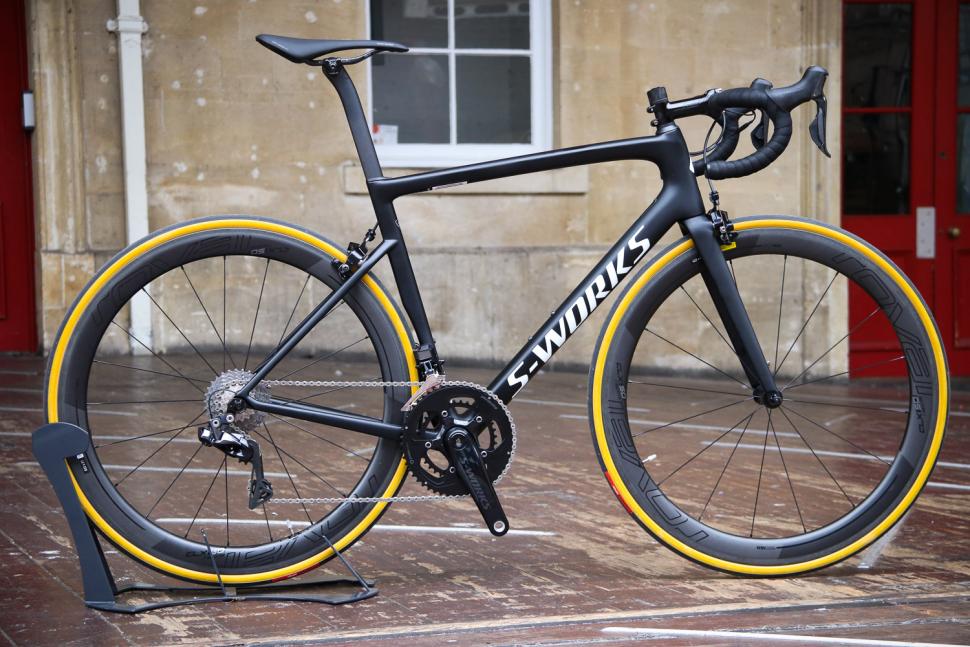
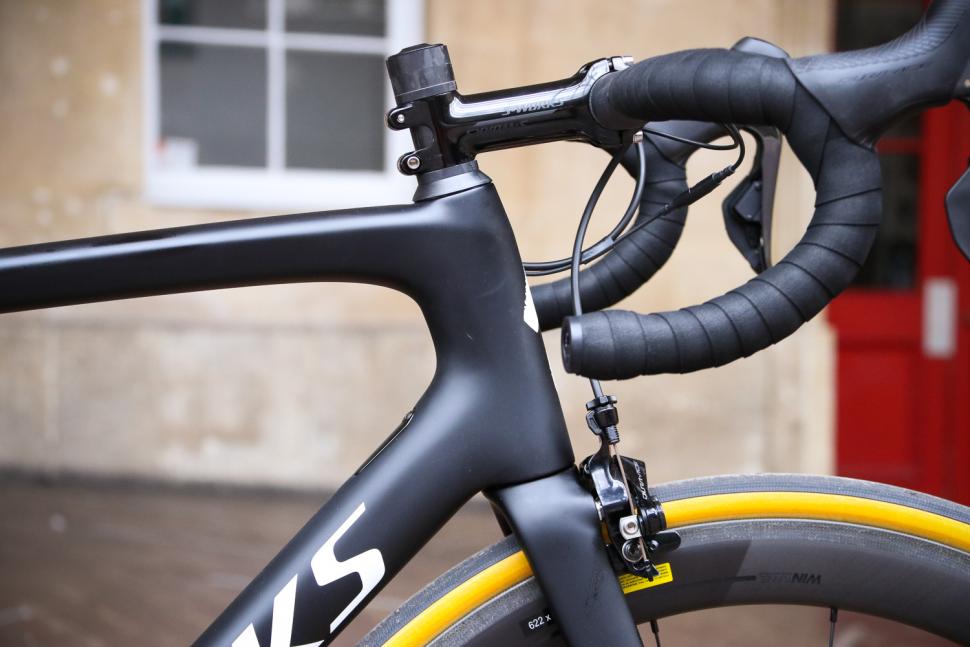

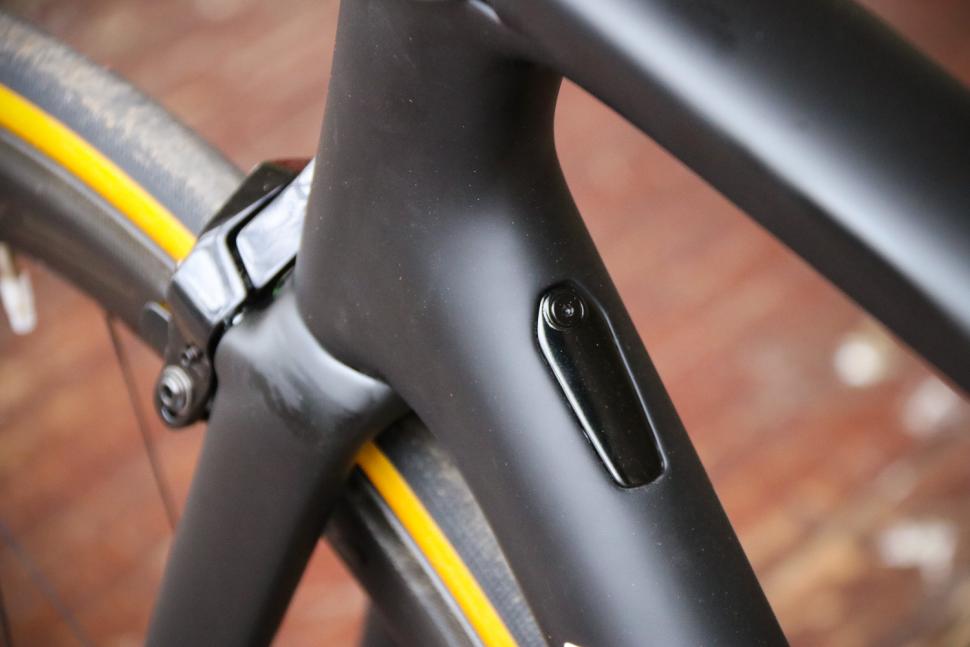
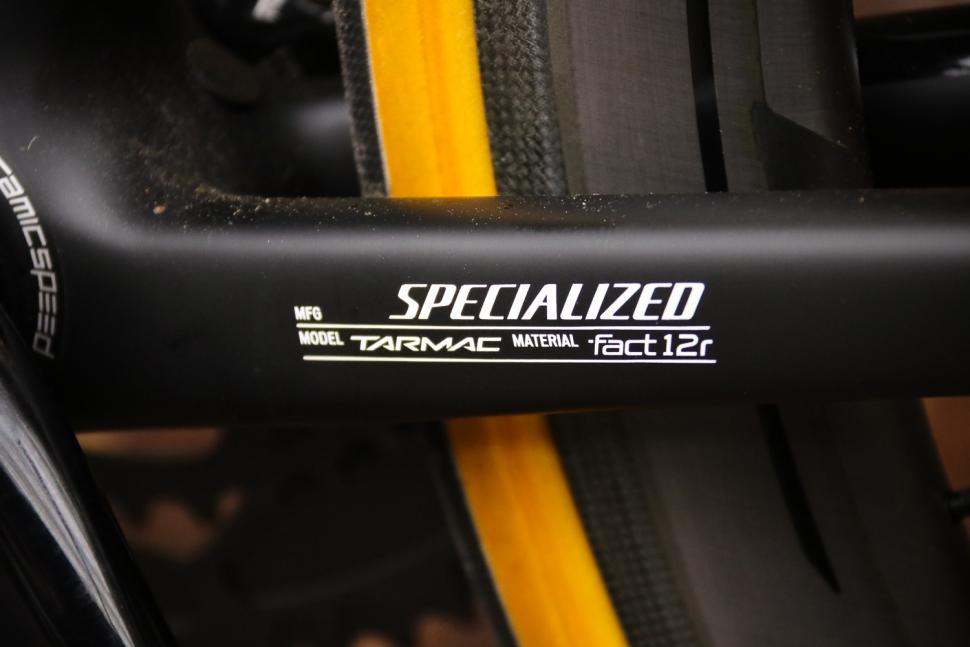


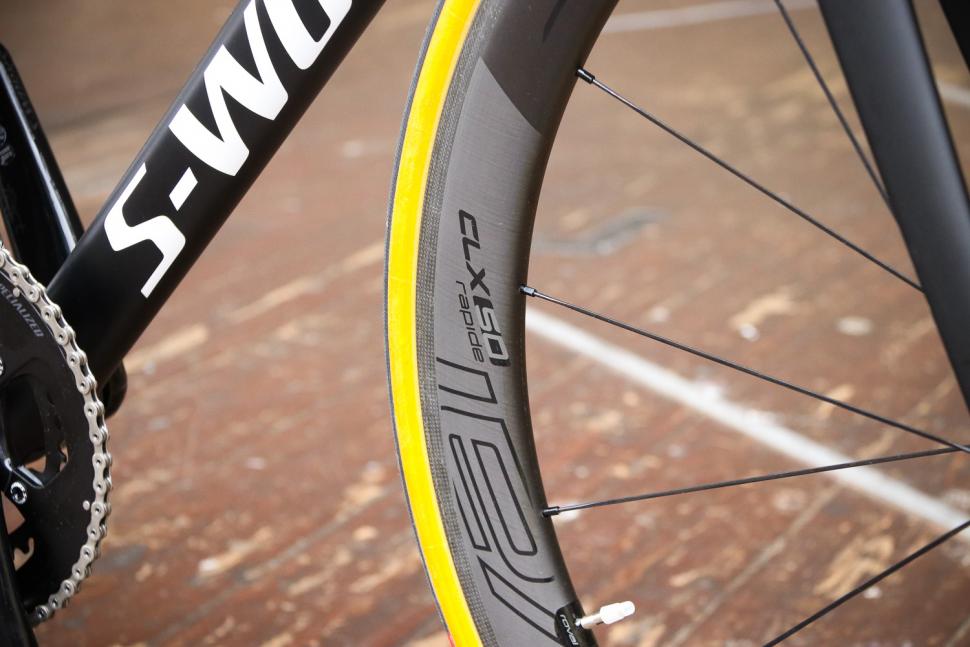

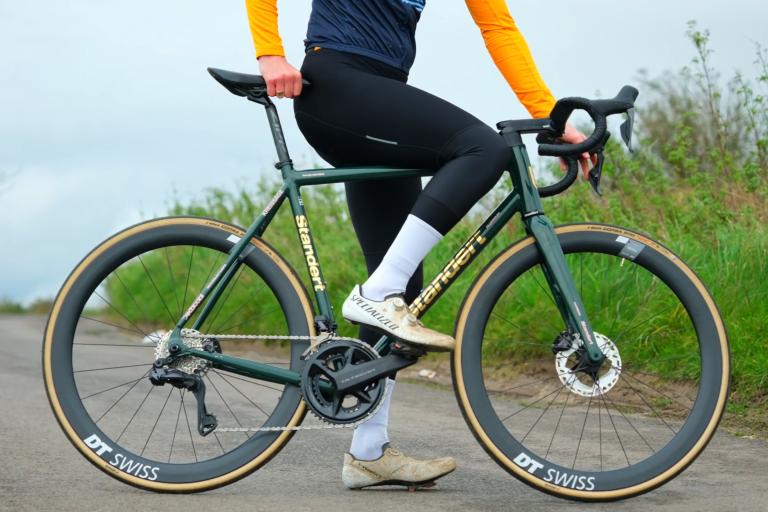
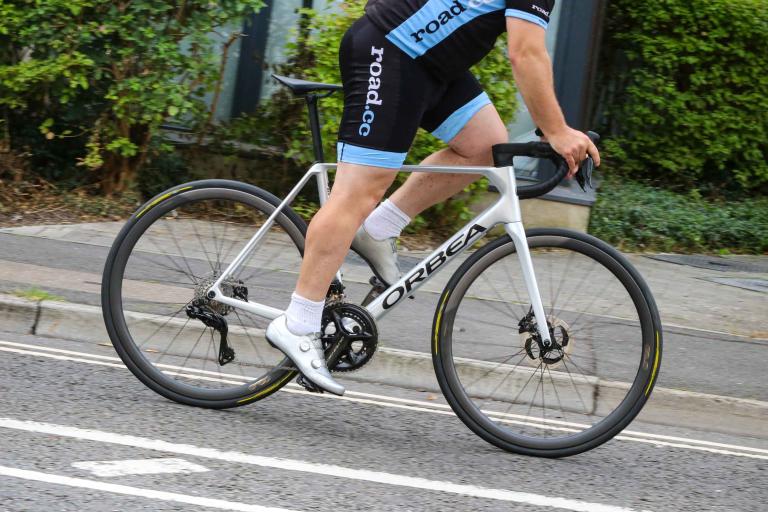
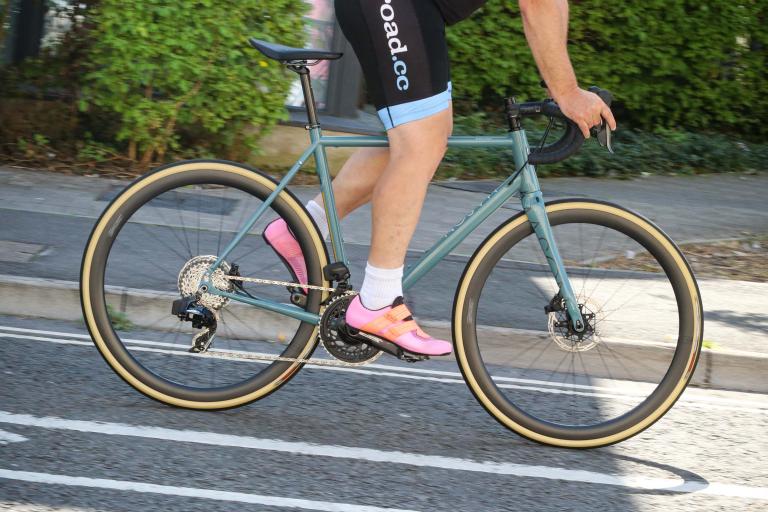
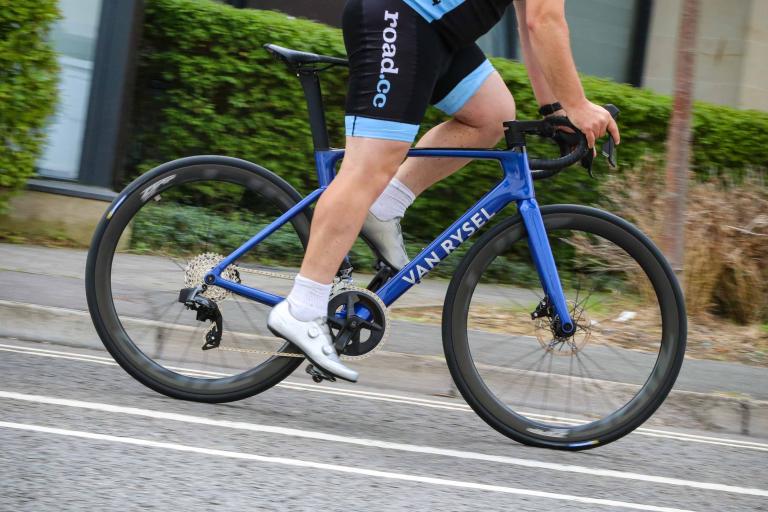
Add new comment
27 comments
Time for a tyre change on this bike - with original CLX 50 & Dura Ace rim brakes. The Turbo Cotton 26s and then S-Works Turbo 26s didn't fare well on Australian roads. I usually run the current rubber at 90-100psi - suits my comfort need. Noting the ability to put tyres up to 30mm on, any opinion on whether GP5000s in 28 work on this bike? Or are 25s better? Looking for some speed and puncture resistance.
I tried the earlier version of the Turbo Cottons and they were cut to pieces within a couple of rides here in the UK - ditto the high TPI Vittorias, though they both 'rode' very well. If I lived in Switzerland it is all I would use.
In the real world GP5000s fare better and I wouldn't hesitate to recommend them. The 28mms ride well on UK roads which are much worse than those in NSW - the last time I visited, at least.
Out of interest how does this compare to a Canyon aeroad? I appreciate one is a genuine aero bike, however, pricing both options up as custom builds the canyon is cheaper. Never been an sworks fan but this certainly caught my eye. Coming from a Super Six Evo HM how do the above compare?
The current Canyon Aeroad is from 2014 and due for an update. Possibly with some prototypes to be seen at TDF. I can't compare it to the new Tarmac, but I rode the Aeroad with DI2 and Enve 4.5 Wheels for about 4000km, and it was fun and actually pretty comfortable, and stupidly fast when I wanted to put the hammer down.
I also own currently a Super Six Evo HM with Sram Red and Zipp 303 NSW, and from an overall perspective the Cannondale is a nicer bike to ride. And never found the SuperSix to come short in any department in comparison to the Canyon. I found the SuperSix better at climbing, weight difference of about 750gr as well in total as well, and also more comfortable to in comparison to the Canyon.
I know this is also very subjective with my weight being 90kg, and everybody has difference preferences in bikes and component choices. But if I had the choice between a Canyon Aeroad frame and a Supersix evo HM frame, irrespectable of component choices, then the Supersix Evo HM would win for me everytime.
IMG_1196.jpg
Only Spesh can do an annonymous plain black bike with OEM components [ only levers/brakes/derailleurs are not spech brand] and can be applaused for it.
sick and tired of the bullshit fed to the mass, stiffer, lighter and more power!
Come on.. 8.5k for a bike! While you can get a stunning custom carbon or steel for third the price and it will be CUSTOM GEOMETRY not one of 4 sizes.
the most souless bike brand ever.
I will never be able to ride such a bike as it deserves to be ridden, so what I can reliably comment is that the paint scheme is fortunately very subtle and elegant.
There's more beautiful and interesting bikes from European manufactuers. Don't buy American!!
Actually there are more beautiful and interesting bikes from UK manufacturers (Enigma for one). Don't buy American or European.
Very interesting to find out the UK isn't part of Europe.
Nooooo don't go there, this thread is clean!
How can a bike be miserable? Or was it just yours because you were riding it?
at £8,500 you'd hope it definitely is in 'superbike territory' as that's a huge price!!
The whole range has been reviewed here and awarded 4.5 stars and we're told the pick might be the '£3.5k ultegra version' but that's clearly a different bike, including frame construction, to the 'mega bucks s works version' you've had to test..
Big price doesn't always guarantee big performance...
The Ultegra version isn't really a different bike as you say, it merely has a lower grade of carbon fibre compared to the S-Works version. How much difference that makes is anyone's guess, I'm hoping to find out by riding it soon.
Previous experience with other bikes that use different carbon through the range tells me that it doesn't always make as big a difference as you might imagine, yes weight is usually a factor but other differences, in the way it rides, can be harder to detect. The changes to the Tarmac platform should hopefully mean the cheaper version rides nearly as well, but I'll soon find out if that is the case or not
The lower grade carbon spec will still benefit from the design itself, but the changes in performance are not entirely linear. They modify the layup schedule and use mostly the same molds. With that said, its a bit of a challenge to achieve the same ride quality between the two due to the use of actual high modulus carbon in specific areas, which instead is swapped out with additional layers of high tesnile mid modulus fibers for a lower cost.
The S-Works series is actually one of the very few bikes out there that utilize high mod carbon in specific areas as most stick with the high tensile stuff only. The high modulus grades can be costly on certain selections. Pinerallo F10 is entirely constructed of the top grade of Toray high tensile carbon. In any case, you really wouldn't entirely high mod carbon bike as it would require extensive enginnering to avoid being overlly rigid and rather brittle.
That's really wierd...because when I asked the main guy at Specialized UK exactly what the difference was between Fact 10 and Fact 12 he said ......... "Well it's just better" when I asked him to quantify that agains say Counterveil or the C60 range he moved onto another topic.
Working for the company doesn't indicate any knowledge on composites. At my office, we handle some composites engineering, but for an entirely different discipline of engineering. A few years back, Specialized had released a small technical blurb about their composites used in road and mountain bikes. They provided their own coding for the products, but it was easy enough to read the Mitsubishi products.
What was on diplay was the FACT 10 was specified utilizing an actual high modulus carbon. Now understand this stuff is very stiff, but its tensile strength is actually much lower than the more commonly used high tesile strength but middling modulus used in the vast majority of frames. The Tarmac in question was hardly a light weight bike, so it wasn't weight being targeted, but likely application was to improve rigidity of specific areas and possibly fine tune frame performance. Now this is hardly the only way to accomplish this, but its a less common route due to material cost. Other engineers may use specific tube shaping and extra carbon sheets in they layup schedule to tune frame performance. This was something the document specified in how they used this specific carbon and it clearly was only a small part of the entire frame construction was made of the high mod stuff.
I brought up the F10 earlier, mainly pointig out that they only used the top grade of high tensile-mid modulus carbon on that bike. Its great stuff, but its not as costly as the high modulus with lower tensile strengh carbon. Looking at Tour's recent test on the frame, you can see Pinorello spent its effort in aerodynamics and geometry, with frame performance taking a few small steps back in comparison. Its BB stiffness wasn't top range, but comparable to bikes like Trek's Emonda. It feels very stiff riding mainly as seatpost compliace is quite low. You don't get much give from that shaped seat statys, seat post, and tube. The head tube and lateral for stiffness weren't top range either, but splay stiffness that is used to bring front end compliance was on the lower side. Still, it handles well mostly due to its very specific geometry, its fairly light, and if Tour's wind tunnel results are accurate, a very aerodynamicly efficient frame. You can see it had one priority and it was to be the what they believed would result in the fastest race bike.
Giant freeliy admits to using a mid range high tensile carbon, but has some really solid frame performance figures. In that case, the engineers applied advanced tube shapes and layup schedule to get there.
As for Bianchi and that CV, I don't think none of the above manufactures do anything similar, but Wilier does with their SEI. I believe they had done it before Bianchi as well, but a different elastomer. So many ways to cook up a carbon frame!
This could have been complete gobbledy-gook, but still sounded hella impressive
If you think wilier design or have an input in their bikes you are mistaken, the Chinese agent comes with the frame to their office with the design, all they have to do is guarantee a number of frame sales per annum. dont be fooled by the bullshit of R&D
Yes fair enough - the 'S Works ' is probably not that different to the normal version and the laws of diminishing return will apply whereby differences are smaller the more you spend.
Nevertheless it IS a different frame with different components so until it's tested you won't actually know if the 'cheap' £3.5K version is relatively as good at it's price point as the mega-bucks version.
Agreed with comments about spending £8.5K+ on a mass produced big brand bike probably made in China. Bonkers.
I'm one of those "love all Italian stuff" suckers but man I always respected and loved Tarmac. Colour schemes were always nice (classic red/black/white, Lambo orange?), people always praised how they ride, so many professional victories (mind blowing fact)...this new one looks awesome (in a BMC way). I love it - but find it crazy expensive. I think 3,500 Ultegra model would be the best purchase, as stated by the author, this time next year for 2,700. On the other hand, I really don't like Spesh and what it represents. In a similar way, I always felt the same about Super Six Evo and I'm not sure I'll be rich enough to ever buy these great "American classics" instead of an "Italian". Depressing fact :(.
Brilliant write up. Slightly baffled by the four and half rating however. You describe the bike as flawless, and reading the review it sounds like it. So why dock half a star? Price? A Ferrari or equivalent would still get a five star rating despite it costing £200,000 or something. I read a lot of your reviews and I'm not sure I've read such a glowing review so if anything deserves a five star rating it's this.
Lovely, thanks.
It's noted that the BB is "slimmer" than the older Tarmac frames. In what way please as the old OSBB system was quite narrow to begin with - 62/3mm shell width if I recall compared to the industry standard of 68mm.
Also; can you run a mechanical groupset on it?
I just mean visually there's less carbon reinforcement around the BB shell compared to the old bike, it's still the same OSBB standard as before.
Yes you can run a mechanical groupset, and Specialized sell the new frame with mechanical groupsets. See that plastic port in the top of the downtube? That's replaced with a cable entry port for mech groupsets.
'Gor blimey...whatever post went on with those photographs they make those Cotton Turbos look TERRIBLE!
someone got jiggy with the hue/saturation sliders in photoshop I'd say. bright yellow in one image, illiminous orange in another!
You didn't like it then?